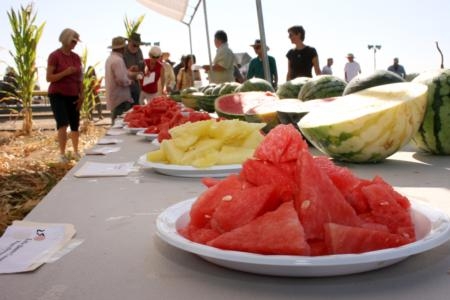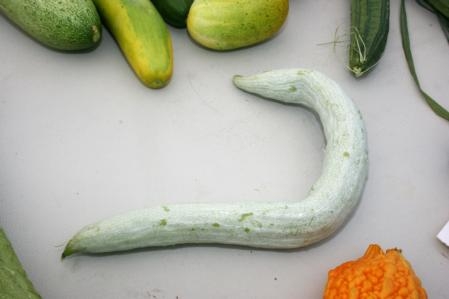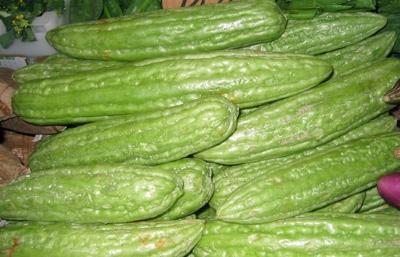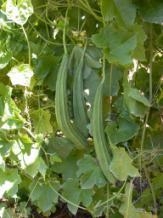Posts Tagged: Southeast Asian
Demand increases for Asian vegetables
Richard Molinar, UC Cooperative Extension advisor in Fresno County, told the reporter that demand is driving increased cultivation of Asian vegetables in Fresno County.
"We have around 50 to 75 Chinese farmers here in Fresno County and over 2,000 acres of Chinese crops selling locally as well as nationwide," Molinar said.
The article noted that UC Cooperative Extension offers advice and services to these growers.
"In addition to providing them with technical support, we also help those farmers to find new marketing opportunities," Molinar said.
UCCE makes Southeast Asian vegetables easy to eat
Most Americans gravitate toward the familiar in supermarket produce aisles. But some creative shopping unveils a tremendous diversity of edible vegetables that can turn an ordinary menu into a much more interesting cuisine.
At certain roadside stands, at farmers markets that cater to diverse clientele and in small Asian supermarkets, adventurous Californians can buy vegetables like bitter melon, Chinese long beans, opo and luffa. Finding them is the first step, knowing how to prepare them is another matter. UC Cooperative Extension has made these less familiar vegetables more accessible by creating a collection of easy-to-cook and nutritious Southeast Asian vegetable recipes.
The recipes were developed by UCCE nutrition educators in Fresno and the statewide UC Expanded Food and Nutrition Education Program team with Richard Molinar, a UCCE advisor in Fresno County. Connie Schneider, director of the UC Youth, Families and Communities Program, and Molinar started by researching the traditional usage of Asian vegetables. They modified some ingredients and procedures in the recipes to simplify preparation and improve the nutritional profile.
“We minimized the number of ingredients in each recipe, added clear measurements and tested the dishes,” Schneider said. “They are delicious.”
For the last 18 years, Molinar has worked with small-scale farmers in Fresno County, which boasts the largest concentration of Hmong farmers in the U.S. Fresno County is also home to farmers of other ethnicities from Laos, China and Vietnam. Molinar and his assistant, Michael Yang, have introduced Southeast Asian immigrant farmers to the latest farming technologies, helped them develop plans to ensure the safety of the food they grow, and worked with them to find new marketing opportunities. Many of these farmers have begun growing vegetables common in California, and most have also kept some space on the farm for the vegetables of their homelands.
The UCCE educators recognized that the rich culinary traditions of local Southeast Asian immigrants could be adapted and used by people of all cultures to increase their consumption of vegetables. Besides, encouraging consumption of Southeast Asian vegetables adds new marketing opportunities for the farmers.
“This has been a unique opportunity to bring UCCE’s farm advisors and nutrition educators together to assist farmers and the public,” Molinar said. “These recipes will encourage more people to buy these nutritious vegetables, expanding the market for the growers.”
The 12 recipes are printed on cards, each with photos of the fresh vegetable and background information. For example, the recipe card for “bitter melon stir fry” notes that the crinkly skinned vegetable is native to India and is eaten when young and green, as bitterness increases with age. The recipe is accompanied by a photo of the prepared dish and complete nutrition facts per serving.
Most people are familiar with luffa after it has dried into a natural scrubby. It is often found near beauty products in stores and purchased to exfoliate the skin. However, the UCCE recipe card for “luffa and prawns” notes that fresh green luffa has a similar but sweeter flavor than zucchini summer squash when stir fried. Either the smooth or angled varieties of luffa can be used in the recipe.
"I grew up with zucchini," Molinar said, "but I prefer the flavor and texture of angled luffa."
The printed cards will be distributed at farmers markets where Southeast Asian vegetables are sold, and they are available on the Fresno County UC Cooperative Extension website. Farmers who sell Asian vegetables at farmers markets may pick up 10 packets of recipes for free at the UC Cooperative Extension in Fresno, 1720 S. Maple Ave., Fresno. Direct links to each of the recipes are below:
- Bitter Melon Stir Fry
- Chinese Long Bean and Tofu Salad
- Chinese Winter Melon Chicken Soup
- Field of Greens Salad
- Fuzzy Gourd Stuffed with Pork and Mushrooms
- Lemongrass Chicken Soup
- Luffa and Prawns
- Marinated Japanese Eggplant
- Opo and Beef
- Snow Pea Daikon Salad
- Strawberry Spring Rolls
- Spicy Shrimp and Bok Choy Noodle Bowl
Following are two sample recipes:
Bitter Melon Sir Fry
Serves 4
Ingredients:
1 ripe bitter melon, seeded and sliced
1 tablespoon olive oil
1 onion, diced
3 garlic cloves, crushed
½ lb. ground pork
½ lb. medium shrimp, peeled and deveined
1 tomato, chopped
1 tablespoon reduced sodium soy sauce
Pepper to taste
Directions:
- Place sliced bitter melon in boiling water until just tender (2-3 minutes). Drain
- Heat olive oil in skillet over medium heat. Sauté onions for about 5 minutes until tender.
- Add garlic; sauté an additional 2 minutes; mix in pork and cook until no longer pink.
- Add shrimp; cook about 5 minutes until done.
- Add tomato, bitter melon, and soy sauce; cook until tender.
Luffa and Prawns
Serves 4
Ingredients:
1 tablespoon vegetable oil
1 garlic clove, minced
1 lb large prawns, peeled and deveined
2 luffa (angled luffa or smooth luffa), chopped
¼ cup bamboo shoots
1 teaspoon coriander
1 tablespoon reduced sodium soy sauce
1 green onion, sliced
Directions:
- Heat oil in a wok/pan; add garlic and stir fry for 1 minute.
- Add prawns; cook until done
- Add luffa; continue to stir fry with prawns until just tender, about 5 minutes.
- Add bamboo shoots, coriander, and soy sauce to pan and stir fry a few minutes
- Sprinkle with green onion and serve.
Kearney research station a Fresno County 'gem'
In the waning days of her tenure at the Fresno Bee, food writer Joan Obra devoted an entire column to the UC Kearney Agricultural Research and Extension Center near Parlier.
When she first announced her decision to leave the Bee to return to her family's Hawaii coffee farm, Obra wrote rapturously about the UC Lindcove Research and Extension Center. Her following column said, "I'm not yet done telling you stories." She then recounted treasures she discovered over the years during tours of the 330-acre Kearney station near Parlier.
Obra was fascinated by:
- A demonstration planting of medicinal and culinary herbs from Southeast Asia which includes common and scientific names for the plants.
- Sichuan peppers that she wrote "nearly choked me," planted by UC Cooperative Extension farm advisor Richard Molinar at Kearney as a possible California specialty crop.
- A late summer field day where she tried more than 20 varieties of mini watermelons. "The red flesh of the Little Deuce Coupe was pleasingly crunchy but not super sweet. And the sunny interior of the Mini Yellow was sweeter but not as crisp," Obra wrote.
- Jujubes. Not the artificially flavored candy that sticks to your teeth, but small apple-like fruit important in Asian communities.

A watermelon field day at Kearney. (Photo: B. Dawson)
UC event documented in photos, but not in spirit
The beautiful strawberry stand photos that graced a New York Times story yesterday about the locavore movement were shot at a UC event last Friday designed to remind Sacramento residents about the beginning of their local strawberry season and promote two UC initiatives to help local growers.
It was great that Time's photographer Max Whitaker showed up, but it would've been nice to have credited UC for the purpose of the gathering. UC researchers received a half-million-dollar grant from USDA to work closely with Southeast Asian farmers in Sacramento and Fresno counties on improving production practices, ensuring food safety and expanding their markets.
Not that the Times story wasn't interesting. It focused on a new advertising campaign for Lays Potato Chips that extols their connection to farmers and local communities. The story, written by Kim Severson, said food producers and large-scale farming concerns are embracing a broad interpretation of what eating locally means.
"This mission creep has the original locavores choking on their yerba mate," Severson wrote.
In fairness, the article did touch on the second program promoted at last week's strawberry stand event, but without mentioning UC. The "Grow Local and Buy Local" initiative - a collaborative effort with UC and the Sacramento Farm Bureau that is funded with a $50,000 grant from the Sacramento Board of Supervisors - is designed to take advantage of the close proximity of Sacramento's farms and consumers.
Part of the money is being used to encourage 3,000 area farmers to grow acres of what the Severson calls "grocery store crops," like strawberries and artichokes instead of "commodity crops," like safflower and alfalfa, or to sell more fruit fresh, rather than sending it to canners.
The fresh produce can then be marketed as "local" and sold to nearby hospitals, schools, jails and other institutions that want to buy food grown nearby, and sold direct to consumers at local farmers markets, flea markets and road side stands.
The New York Times wasn't the only media outlet to come to the strawberry stand. Sacramento County UC Cooperative Extension farm advisor Jenny Broome said representatives from the ag publication Capital Press, KCRA Channel 3 News, and the Elk Grove Citizen covered the event.

Sacramento strawberry stand.



